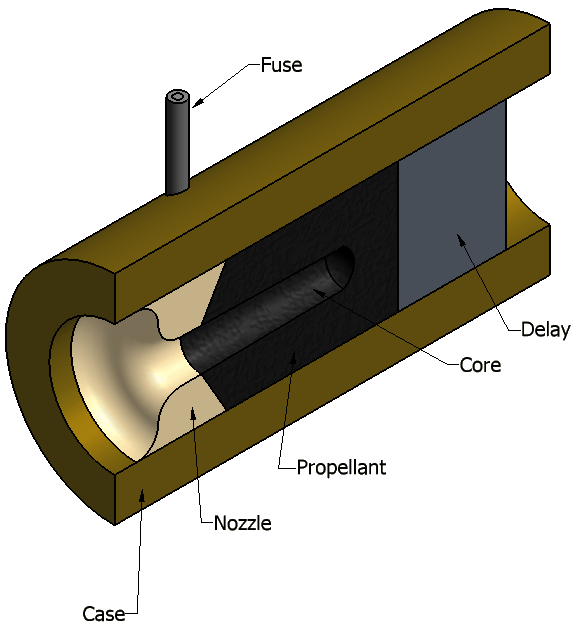
July, 2005
This is a design for a spin-stabilized pyrotechnic rocket and the tooling to make them. This style is commonly known as a "Stinger missile" after the item sold commercially under that name as consumer fireworks (UN class 1.4g, formerly called "Class C", fireworks; commonly misspelled as "stinger missle").
While a classic core-burning rocket works with a single axial nozzle for thrust, this design adds a second tangential thrust port that burns briefly before the axial nozzle lights. The tangential port imparts an axial spin (that is, along the "roll" axis in aeronautical terms) that gyroscopically stabilizes the device. Like a stick or fins, the spin keeps the rocket flying straight along its original axis direction. This clever principle means that one can make a rocket consisting of nothing more than the motor itself. At the launch, you also get a bonus "wheel" effect while the device spins on its launcher.
This page simply presents detailed specifications and mechanical drawings for the device design and the tooling; it does not attempt to explain the chemical ingredients, or their acquisition, processing, or loading.
The device components are:

This design has been successfully tested in the 3/4 inch ID scale with both my black powder fuel recipe (equal parts meal powder and chrysanthemum 6, optional addition of 5 percent titanium 40-mesh, rammed) and whistle composition fuel (7 KCL04, 3 Na benzoate, 1 Fe2O3, riced with the petrolatum/naphtha mixing process, and pressed to 1500 lbs on 3/4 inch ID) as propellants, and chrysanthemum 6 as delay. In the case of whistle propellant, the clay and delay are omitted; and what would have been the nozzle and delay increments are just a continuous cored grain of whistle composition from the bottom up to and including the delay.
Other sizes: Like conventional core-burning rockets, this design is reputed to simply scale linearly to other sizes such as the 1-inch or 1-1/4-inch tubes would yield, but I myself have not tested this ability. If this reputation is correct, one could take the dimensions specified in the drawings and just scale them up for a larger size. Some tooling sets increase the spindle length proportion by about 20 to 50 percent longer than mine for the black powder fuel, but I feel the stubbier length is an appropriate compromise to accommodate both black powder and whistle composition, and simplifies the loading by only requiring one hollow and one solid drift.
Fusing: Note that the fuse shown in the models of the finished device is truncated from what is used in practice, which should be several inches long to provide a suitable interval between "light fuse", "retire", and launch. The 3/32 inch Visco shown works with the 3/4 inch ID size, but scaling up may require a thicker fuse for a larger spin thruster nozzle.
Origins: These specifications are not my original work; what I have done is to take a composite of the details drawn by others for the device (who were in turn copying the Chinese), and refine the tooling a bit for my own aesthetics and notions of mechanical refinements. I also have integrated what I know about small conventional rockets from building them and from classic references such as Weingart's Pyrotechnics (1947), Shimizu's Fireworks: The Art, Science and Technique (1982), and Lancaster's Fireworks: Principles and Practice (2nd edition, 1992). The mechanical drawings themselves are my original renderings, for which I used the best of the software currently available for solid modeling and computer-aided design.
History and References: My recollection is that this rocket design was introduced sometime in the late 1980s as a commerical item made in China for consumer fireworks such as are sold in the USA. The pyrotechnic hobby took interest in them, and Warren Klofkorn in 1989 wrote an article analysing the design and fabrication, which was published in American Fireworks News (http://www.fireworksnews.com/) and reprinted by them in their "Best of" collections and currently in a separately-sold reprint. Dan Williams has an excellent tutorial page on construction, assuming you already have the tools. Kyle Kepley's passfire.com [paid subscription site] has an article on improvising wooden versions of similar tools in a much larger size (1.5 inch ID).
Commercial sources:
For those who are not equipped for the metalworking,
Rich Wolter (http://www.wolterpyrotools.com/)
is reputed to make excellent Stinger missile tooling sets in various sizes.
Greg Boyd (http://www.pyrotooling.com/)
is another well-reputed craftsman of rocket tools.
Both have very reasonable prices, considering the considerable machining effort involved.